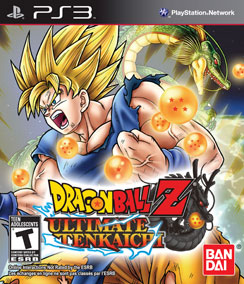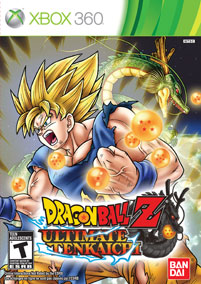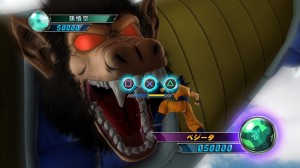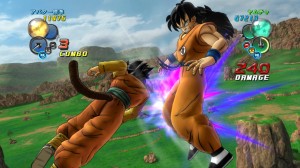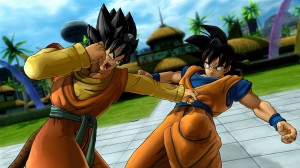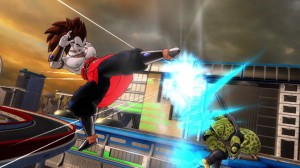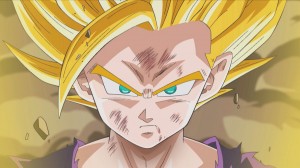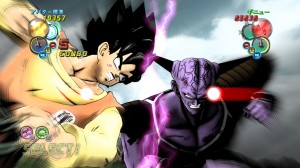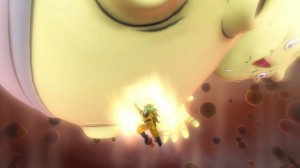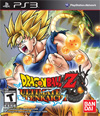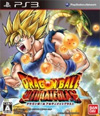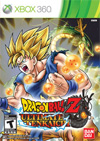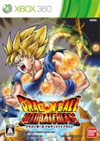Before its release, we were all wondering if Raging Blast 2 was as far as developer Spike and publisher Namco-Bandai could string everyone along — it was the sequel to an HD reboot (Raging Blast) of a three-game franchise from a prior generation of consoles (Sparking!), not to mention the portable version from the year before (TAG VS). Where was there left to go? With sales continuing to dwindle, it seemed that even a bonus video inclusion was not enough to revitalize interest in the series.
It was time for something new. Could something “new” really be done in a single year, though?
Enter Game Project Age 2011. Or Ultimate Tenkaichi. Or Ultimate Blast. Or whatever it is we are calling the game this week.
Quick Details:
| ASIN: | B002I0K4QU (PS3), B003O6G8C6 (360) |
| Developer: | Spike |
| Publisher: | Namco-Bandai |
| Release Date: | 25 October 2011 |
| MSRP: | $59.99 |
| Platforms: | PlayStation 3, Xbox 360 |
|
|
|

Review of this game was made possible through your Amazon referral purchases. If you are interested in contributing to the site, please visit our “Donate” page or contact us directly.
Review by: Mike LaBrie (VegettoEX)
So how about that there video game…?
How We Gamed
It was no secret that I was past my limit of being able to deal with yet another Dragon Ball fighting game from Spike released in autumn where I played from Raditz up through Boo. Ultimate Butōden earlier in the year was a slight exception — it fell into the same traps in terms of the same story line, but the “What If?” battles, a completely different developer with a completely different play style, and loads of fun unlockables (at last play, my Vegetto had sunglasses, bunny ears, and Nyoi-bō) helped set it apart from the other yearly drivel.
Ultimate Tenkaichi was going in two simultaneous directions — it had the standard ol’ Raditz-to-Boo “Z”-era story mode, but it also had its own completely original story mode that revolved around a hero character of your own creation. He (and only he; there are no female options) had to be of Saiyan descent, but it was finally a true character creation mode for the franchise with its own story.
A main draw of this game was the all-new, 2D animation cut-scenes developed by Toei and littered throughout the traditional story mode. As such, I wanted to jump in there first to at least get a taste, especially after the impressive opening animation set to “CHA-LA HEAD-CHA-LA”. I made my way through the opening chapter to reach the Ōzaru Vegeta battle, which is exactly where I left the story mode for quite some time — the QTE (“Quick Time Events”) presses felt like they had virtually no window, dragged on far too long, and it was unbearable waiting to get back into the action after each failed attempt.
It was therefore time to jump over to the character creation “Hero Mode”, where I spent the majority of time with the game. Aside from finishing up the training mode, some online dabbling, and a quick jump back to the traditional story mode, aimlessly doing “training” missions under different “masters” and flying from random spot to random spot on the map was my main Ultimate Tenkaichi experience.
Presentation
Ultimate Tenkaichi is a plastic sheen on top of Raging Blast 2 — that is really the best and only way to describe it. Everything seems to glow a little more and has a little extra saturation to it. The excessive blurs and in particular the warping/warbling visual effect that happens with a wide variety of special attacks also adds to the feeling.
It is getting more and more difficult to assess these presentation changes, though. More than ever before, it feels as if they are adding little sparkles just to make it look ever-so-slightly-different from the prior year’s game(s), with the main problem being that they are all blending together at this point. Does it look “better”, does it look “worse”, or does it simply look “different”…?
Since you are so busy watching the game rather than playing it, Spike has gone the extra mile and added in lots of little flairs and dynamic angles to just about every little movement in the game. Everything continues to fly by at a steady 60 frames-per-second, and even the standard lag during online battles barely slows down the action the tiniest bit. Past games have always tried to mirror great “camera work” from the TV series’ and movies’ memorable fights (such as Goku and Vegeta’s first battle, particularly with the Kaiō-ken flurry of attacks), but Ultimate Tenkaichi amps this up to eleven — it feels as if every single attack is that momentous, receiving crazy turn-arounds, zooms, fades, and swoops. It is a good thing you do not have to press many buttons, because you otherwise might miss out on all the great action.
It may just be an illusion due to the number of times that Ultimate Tenkaichi brings everything to a grinding halt (more on that when discussing the actual gameplay), but the facial animations get a little extra time to shine this time around. Dodging hits and suffering stronger attacks bring out the smirks and grimaces on character faces, which helps bring a little extra character to the… well, characters.
The “original” characters are where Ultimate Tenkaichi theoretically gets a chance to show off a little bit more. In reality, the custom characters are not as “original” as one might think — their various design aspects are all pulled from the Japanese, card-based, arcade-only game Dragon Ball Heroes. The “Hero” and “Berserker” characters in particular are well-represented in Ultimate Tenkaichi:
The thing is, these characters are just not that interesting. By having a story that insists upon the hero character being a specific type of person (specifically Saiyan and male) so the mode can play out according to plan, you really do not ever feel as if the character is your own. The customization options are immensely limited from the start, and barely expand as you unlock more options throughout the “Hero” mode. You can look forward to creating some type of Saiyan character of barely-different-heights with maybe a tail and maybe a scouter, and adjust the tone and inflection of the voice a little bit… but that is really it. It makes sense why the character creation has to be the way it is to go along with the story, but that holds it back so much at the same time that you start to wonder if it was worth it.
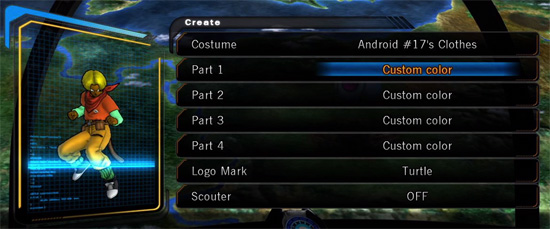
If your character does not look like everyone else’s Dragon Ball AF-esque Goku/Vegeta/Broli hybrid, a color change will only go so far to separate you from the crowd.
The giant boss characters are the impressive ones of the bunch. We had some larger characters back in Sparking! METEOR on the PS2 and Wii, but it was really back in 1997’s Final Bout that we had a boss character as large as (well, larger than!) the screen itself. Characters in Ultimate Tenkaichi like Ōzaru Vegeta (and the Baby incarnation of him, as well) legitimately feel as if they are going to overwhelm you and your TV.
As noted earlier, though the game does not contain a self-contained animated story a la Plan to Eradicate the Super Saiyans, the traditional story mode does sprinkle newly animated cut-scenes throughout itself. Some of the choices are obvious (Goku turning into a Super Saiyan for the first time), while others will leave you scratching your head (Yajirobe cutting off Vegeta’s tail). They do exactly what they set out to do — which is to say they look gorgeous bringing the series into high-definition — but simultaneously have a little bit of that empty-soul to them. The crispness of the drawings themselves is fantastic, but the amount of animation is lacking. They are a fun little distraction, but for me the problem is — yet again — I have already seen the series many times over, so the amount of times Namco-Bandai can trick me into experiencing it again and again grows more and more limited and frustrating.
As with the two Raging Blast games, the Japanese version (Ultimate Blast) does indeed contain re-orchestrated versions of Shunsuke Kikuchi’s score from the TV series and movies (plus some nods to both GT and Kai), while the international release (Ultimate Tenkaichi) has a replacement score. The actual music from the franchise made such an impact on the games back in the Sparking! era, and for us to still be missing such a huge component of the presentation is particularly maddening.
Oh, and hey… if we are going to get a capsule-shooting loading screen mini-game, can it serve a purpose again? There is nothing to “purchase” with any in-game currency this time around, so you essentially have no reason to press any button to shoot them down. Give me spinning Kame-Sen’nin again, or give me something to buy. This is just pointless.
This year’s health / power / etc. meter display thing thinks it is making things nice and obvious:
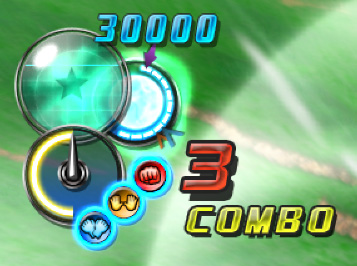
… but really just looks as convoluted as ever, which I suppose fits right at home in the context of the rest of the game.
Ultimate Tenkaichi continues to carry forward the Dragon Ball Kai voice cast, meaning Hikaru Midorikawa as Tenshinhan (replacing the late Hirotaka Suzuoki), Hiroaki Miura as Zarbon (replacing the very-much-alive Shō Hayami), etc. While I obviously went through the game in Japanese, it is probably worth noting that the game in many cases literally just rips voice samples from prior games — it will probably be most noticeable on the English side, since the Kai voice cast was not in full effect until Raging Blast 2. This means that Freeza will shift between prior voice actress Linda Young and current voice actor Chris Ayres between two sentences, and then right back again.
Gameplay
When Game Project Age 2011 was announced, I unconsciously imposed a sort of quasi-media-blackout of the game on myself. It was a little difficult when you consider the fact that I was still actively covering news about the game during its development, but I never went to any extreme lengths to analyze screen shots and trailers to attempt to “figure out” how the game was going to work. It was clear that Spike was taking the series in a somewhat different direction, but it still had that “Tenkaichi” word in its (domestic) title, meaning it still had to call back to the prior games… right? Somehow? Wouldn’t it?
What we ended up with was a game of Rock, Paper, Scissors grafted on top of a game that, last year, you were able to actually control. Not this year, though. Nuh-uh.
Wait… hold up, hold up. What did I say last year?
That being said, the control scheme is still a complete train wreck. There is simply so much that these characters can do, that even a PS3 or 360 controller cannot fully encompass all of these techniques. What will at first appear as obvious and logical combinations of buttons will be quickly forgotten in the heat of the moment: pressing “X” (PS3) / “A” (360) to dash in can be combined with “R1” (PS3) / “RT” (360) to fly up to create a dashing upward flight, but the alluded-to cramping takes over and all too often I found myself double-tapping the dash button to fly behind my opponent in hopes of catching them off-guard that way, instead. It is that exact situation — relying on a small, base set of moves from a much larger inventory — which proves that only those dedicated to the cause will ever incorporate each and every movement into their arsenal.
That is correct — I just got done explaining how convoluted and unapproachable the control scheme had become. Am I going back on that? Spike just heeded my call and gave me everything I wanted by reducing the game’s controls down to something manageable that still results in an impressive presentation and feeling of power. I wanted that, right?
I was wrong.
Well, maybe not entirely, but definitely a little bit. The problem here is that Spike had reduced the control down so much that you rarely feel as if there is any control at all. The instant a fight begins, it feels like an almost traditional 2Dish (from the sidelines) view of any other fight from the prior Sparking! or Raging Blast games — you can dash in, punch, kick, fire some minor ki blasts, etc. The instant anything truly clashes, however, you are thrown into the aforementioned RPS guessing game.
Do you win the clash? Your reward is extra hits that you do not get to manually control! Do you lose the clash? Well, it is back to the drawing board with both of your positions reset — start all over, again!
Perhaps it is just because I come from a background filled with fighting games, but that was one of my biggest complaints about how fights in Ultimate Tenkaichi played out. Any time an initiative was countered or interrupted, the characters will do a little hop backward to “reset” their orientation with regard to one another as if they fight had just begun. This means that, rather than having an opportunity to punish your opponent for missing or following up your own successful jab, there is no major upside to… well, anything. If the characters are constantly going to hop back to a reset position, what incentive is there for me to play aggressively or defensively? Am I even playing this game in the first place?
It just feels as if every single little thing you do results in an, “OK you two — press a button, and let’s see if you (and, get this, it’s super crazy now…) pressed the same button!” Everything is set up to compare button presses and initiate another chain attack, which itself gives you an opportunity to either… well, continue the chain attack if you are the “winner”, or press a whole bunch of buttons at once to interrupt it if you are the “loser”… which, again, gives you a short button-press mini-game to see if you “win” that interruption. We keep writing the game off as Rock, Paper, Scissors, but most of the time you are only given two choices.
I have a hard time understanding why Spike shifted the battles into distinct “Melee” and “Blast” ranges. “Blast Range” always seems to end up with us firing ki blasts and auto-dashing into “Melee Range” anyway, and “Melee Range” just ends up in a chain combo since, well, what else can you do? Much like the rest of the game, it feels like an incomplete thought or design.
Returning to the giant boss fights, they are somehow both the most frustrating (if that was not clear already) and most fun part of the entire game. The repetitive, memorization-necessary nature of them — especially on any difficulty other than “easy” — will make you want to toss your controller across the room, also partially due to the slight delay from your button press to the on-screen confirmation. At the same time, they are so different from the regular fighting that it feels like a (very welcome) breath of fresh air. These fights were always some of the most dire and interesting in the power-inflated sections of the series and movies, and it truly does feel as if you are reliving them through the game… albeit through an endless series of QTEs.
The Raging Blast games were also finally starting to correct one of the biggest faults in Spike’s games, which is that every single character essentially plays the same. Ultimate Tenkaichi turns this right back on its head. Choose anyone you want (from the “reduced” roster that is, since it does have fewer characters than the two prior games), because you will be doing the exact same chain combo launches and interrupts no matter who it is you end up with.
Final Thoughts
Ultimate Tenkaichi is in a tough spot. Fans were led to believe it would truly be an “ultimate” version of what they had already been playing for five years. Were it titled something else (without the “Tenkaichi” or “Blast” branding) and not so clearly just last year’s game wrapped up in plastic, perhaps expectations would have been different.
Even if you had no preconceptions coming into the game with regard to its name/branding, I struggle to understand how anyone could find any ongoing amount of “fun” contained inside. I hesitate to say “never”, but it truly is almost never an enjoyable experience. You will spend more time watching the game than playing the game, and the frustrating limitations of what little gameplay there is will not win over anyone looking to actually play the game they bought.
We have since learned that 2012’s upcoming main console game — Dragon Ball Z for Kinect — will essentially be a buttonless skin tossed over top Ultimate Tenkaichi (itself just a control-removed skin over top Raging Blast 2). This may actually be for the best. If Spike and Namco-Bandai want to reduce the game down to the smallest amount of inputs for the maximum amount of “showy” output, an arms-flailing game is probably the way to go.
Ultimate Tenkaichi is the ultimate example of a developer that has been working on the exact same thing over and over for too long. They have burned out their enthusiasm and what few new ideas they had. They need a break. We need a break. A long one. And then we need a new direction.
Someone please make this all stop.
Ultimate Tenkaichi was developed by Spike and published by Namco-Bandai, released in North America on 25 October 2011. MSRP $59.99. Game purchased for review. By review publication, second fight against Yi Xing Long in “Hero Mode” reached, and some forgettable spot along the traditional “Story Mode” reached. Named my custom character “Bokacha”. I don’t remember the pun anymore. Unlocked some stuff, I guess. All tutorials completed. Online multiplayer sessions completed. Multiple cases of beer consumed to dull the pain.
Purchase This Item:
Ultimate Tenkaichi may be available at the following retailers:
| PLAYSTATION 3 | |||
| XBOX 360 | |||

